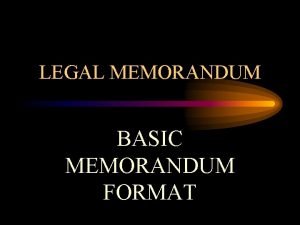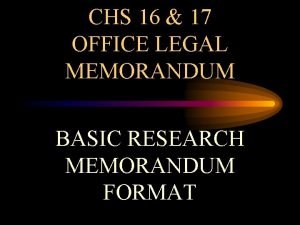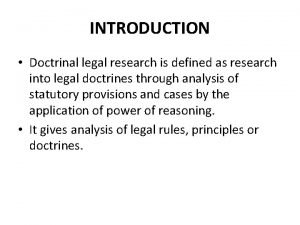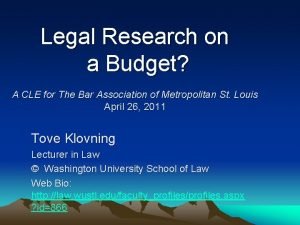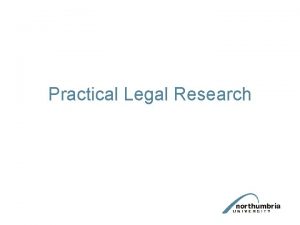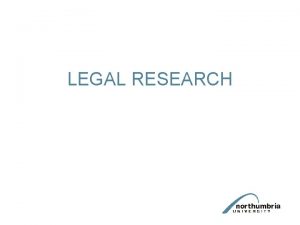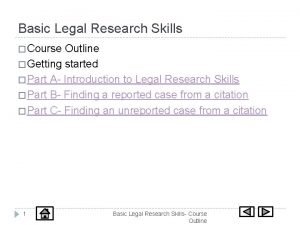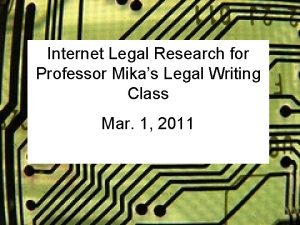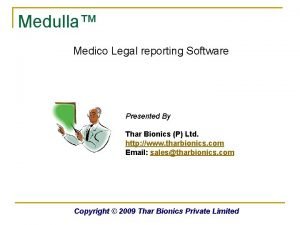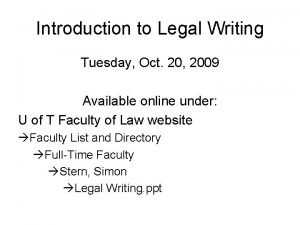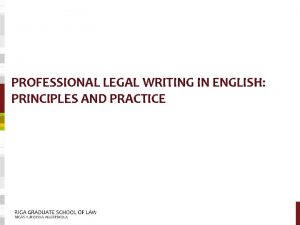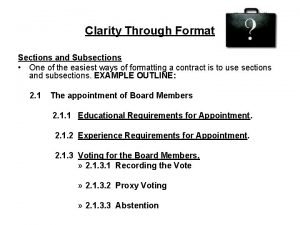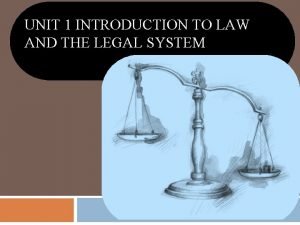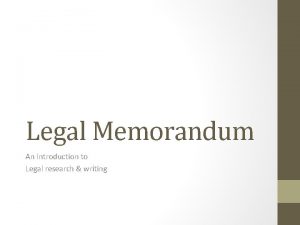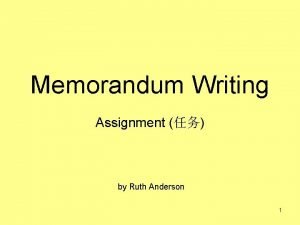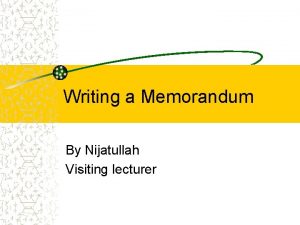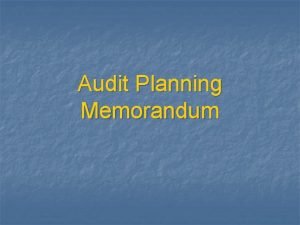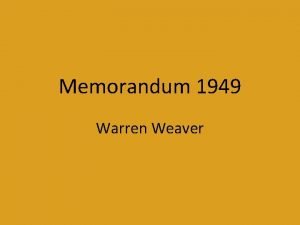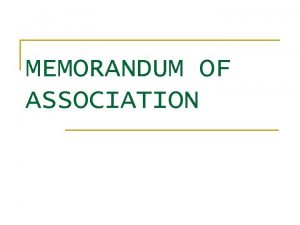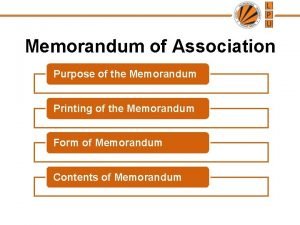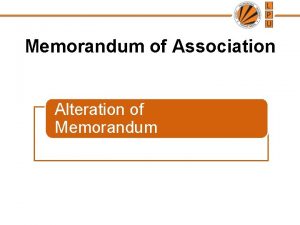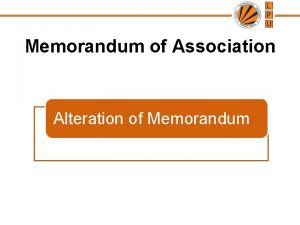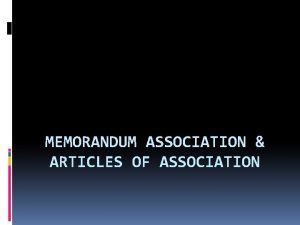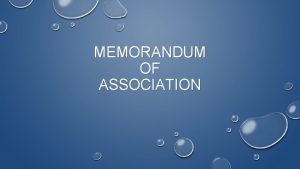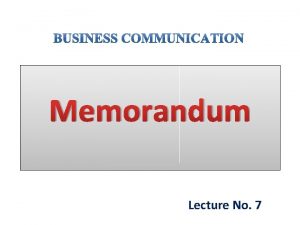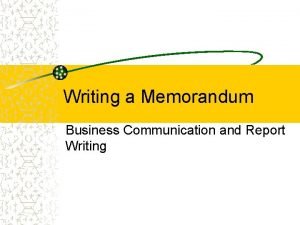Legal Memorandum An Introduction to Legal research writing


















- Slides: 18

Legal Memorandum An Introduction to Legal research & writing

Introduction • It is impossible for lawyers to know every aspect of every area of law • There are literally 100’s of areas and subareas of law • Most new cases involve some novel area of law a lawyer may not know • That is why lawyers do a lot of research and writing • This occurs on a DAILY basis

Scenario Larry the Lawyer just recently got his license to practice law. Larry’s first case is representing Diva Devine. Diva is being sued because she did not save Penny Worthless from a fire; which occurred while Penny was an over-night guest at Diva’s mansion. As a result Penny has minor burns. Penny claims the fire was started when Diva left a burning cigarette on a couch and went to bed. Diva asserts that the house ignited when lightning struck the roof. Larry’s firm has assigned him to research whether a Homeowner has an affirmative duty to save a Guest who is in peril?

Legal Research What will Larry do? He knows this is a Negligence action and possibly in regards to Duty. 1. First Larry “Google's” affirmative duty 2. Not happy with the results he goes to the firm’s Legal Encyclopedias and Hornbooks. These give him a general idea of affirmative duties 3. Larry’s firm has an account with “Northwest Law” a legal research engine; he searches under Washington > Negligence > Duty 4. He is given a multitude of cases and articles on the subject

Legal Research Larry was able to find a these (fictional) cases: • Smith v. Doe, 1 Wn. 3 d 1 (2010). A person has a duty to act reasonably under the circumstances and protect all foreseeable persons from harm. • Poor v. Rich, 1 Wn. 3 d 20 (2010). A homeowner has a duty to save all guests when the cause of the harm to the house was caused by the homeowner’s actions. • Winner v. Wimp, 100 Wn. App. 4 d 100 (Div I 2011). A homeowner did not have an affirmative duty to save a guest from harm when an “Act of God” causes damage/destruction to the owner’s house.

Legal Writing So now what does Larry do? Does he tell his boss there is/is not an affirmative duty? OR Does he write a quick note telling his boss the names of relevant cases? OR Does he compile all the facts – via affidavits of Diva and Penny – and relevant case law and then write up an analysis of the facts and law and provide his boss with his conclusions?

Legal Writing All legal writing follows the same/similar format 1. Statement of Facts 2. Statement of the Issues 3. Discussion of the relevant legal principles and an analysis of law and fact 4. Conclusion 5. *Numbers 2, 3, & 4 are basically IRAC

Analytical v. Persuasive Writing • Analytical Writing applies facts to law to come to a reasonable conclusion consistent with the facts and law • Persuasive Writing makes arguments as to why or why not a rule should or should not apply to the facts of the matter. • Legal/Office Memorandums are Analytical • Memos provide a legal analysis of the issues and what, based on the facts and law, would be a reasonable conclusion.

Memo Format 1. Heading 2. Statement of Facts 3. Statement of the Issue(s) 4. Brief Answer 5. Discussion 6. Conclusion

Heading To: Boss From: Larry Date: May 17, 2011 Re: Homeowner’s affirmative duty to save houseguests _____________________________

Statement of Facts Penny was harmed while staying in Diva’s house caught on fire due to (1) Diva leaving a cigarette on a couch; or (2) lightning struck Diva’s house causing it to catch on fire.

Statement of the Issue(s) UNDER Washington’s rules of negligence, DOES a homeowner have an affirmative duty to save a houseguest WHEN damage to a house was caused by the homeowner’s actions? AND UNDER Washington’s rules of negligence, DOES a homeowner have an affirmative duty to save a house guest WHEN damage to a house was caused by acts beyond the homeowner’s control?

Brief Answer Probably Yes. If Diva caused the fire to the house by leaving a lit cigarette on a couch and going to bed. AND Probably No. If the damage to the house was started after the roof was struck by lightening.

Discussion: Most important part General Law > Specific Law Here Larry would discuss: (deductive logic) 1. Smith v. Doe, which is the general rule of duty 2. Poor v. Rich, if Diva left the cigarette; OR Winner v. Wimp, if lightening caused the fire. He may even discuss both cases. 3. Analyze the facts of the relevant cases as compared to the facts alleged by Penny and Diva. 4. Come up with a sub-conclusion for each Issue.

Conclusion Diva had an affirmative duty to save Penny because the damage to Diva’s house was caused by Diva’s leaving a burning cigarette on a couch. OR Diva did not have an affirmative duty to save Penny because the damage to Diva’s house was caused by lightening; which is an “Act of God. ”

Citation Long Form: 1 st Time a Source is Sited Short Form: Subsequent use of a Source • Sanders v. E-Z Park Inc. , 57 Wn. 2 d 474, 475, 358 P. 2 d 138 (1960) • Sanders, at 475. OR 57 Wn. 2 d at 475. • Noble v. Lubrin, 114 Wn. App. 812, 815, 60 P. 3 d 1224 (Div. 1 2003) • RCW 23 B. 08. 300 (1968) • Noble, at 815. OR 114 Wn. App. , at 815. • RCW 23 B. 08. 300(a)(1)

Instructions 1. Title your Document “Your Name Legal Memo” Example: “Jane Doe Legal Memo” 2. Follow the Format described in class: (1) Heading; (2) Statement of Facts; (3) Statement of the Issues; (4) Short Answer; (5) Discussion; and (6) Conclusion 3. You DO NOT need to cite facts in the Statement of Facts, OR when using the above listed facts in your Discussion Section. 4. You MUST cite anytime you refer to a legal concept from the Statute or one of the Cases. 5. Each of the three (3) questions above must be discussed in separate parts of the Discussion Section – label them accordingly. 6. Font: 12 -point Times New Roman

Instructions 7. 1” X 1” Borders 8. Double-Spaced (Except for the Heading, Statement of the Issues, AND the Short Answer) 9. Ten (10) pages maximum 10. Proof read your work, more than one (1) time. If I cannot understand it, I cannot grade it. 11. Spelling & Grammar Check 12. You may discuss the assignment with other students in this class; however, you must write your OWN memo. 13. This assignment is worth 100 Points toward you final grade. 14. Submit your memo via the Legal Memorandum Dropbox. 15. Memo Instructions give the due date.
 Law memorandum format
Law memorandum format Research memorandum law
Research memorandum law Doctrinal study meaning
Doctrinal study meaning Importance of data in legal research
Importance of data in legal research Legal research cle
Legal research cle Practical legal research report example
Practical legal research report example Practical legal research report example
Practical legal research report example Legal research outline
Legal research outline Legal research methodology
Legal research methodology Operators for advanced internet legal research
Operators for advanced internet legal research Medical legal report software
Medical legal report software Umbrella paragraph legal writing example
Umbrella paragraph legal writing example Principles of legal writing
Principles of legal writing Subsection example
Subsection example Introduction to malaysian legal system
Introduction to malaysian legal system Unit 1 introduction to law and the legal system
Unit 1 introduction to law and the legal system Office memorandum meaning
Office memorandum meaning What is memo?
What is memo? Astro quiz 2021 round 2
Astro quiz 2021 round 2
